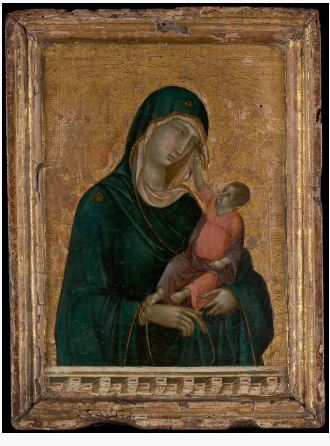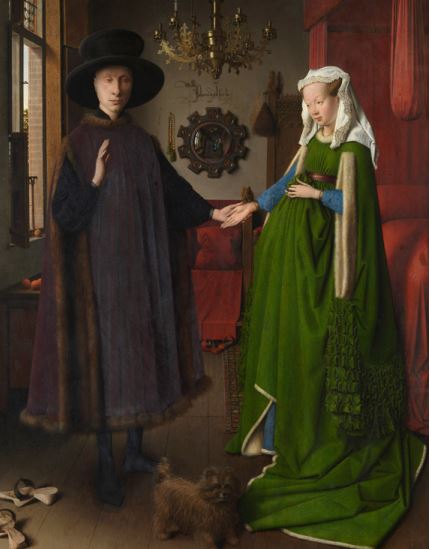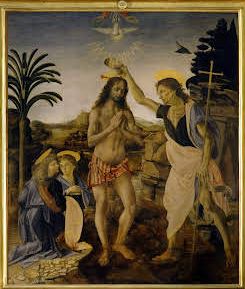The Early Renaissance

Madonna and Child is an art by the Italian artist Duccio di Buoninsegna, completed in around 1308. It shows Virgin Mary with the infant Jesus on her lap. Moreover, it has been in possession of the National Gallery, London, since 1878. The medium used to create this work of art is tempera (Cole, 2018). This is a type of paint that is made from an emulsion of pigments and water-soluble media. These arts are known for their bright colors and flatness of appearance.
The painting depicts the Virgin Mary holding the Christ child in her lap, with both figures surrounded by an intricate halo. One interesting fact about this painting is that it was originally commissioned as part of a much larger altarpiece for the Siena Cathedral (Cole, 2018). However, due to Duccio’s death before its completion, only this central portion was ultimately finished. The painting is characterized by its use of sfumato, or soft shading, which gives the faces of both Mary and Jesus an otherworldly appearance.
The artist depicted the human figure in Madonna and Child with great depth and emotion. The mother is shown staring down at her child with a look of tenderness and love, while the child looks up at her with a mixture of trust and wonder. The artist has managed to capture the intimacy of the moment beautifully, portraying both figures in a very real and lifelike manner. The use of light and shadow similarly helps to create a sense of realism and depth, making the viewer feel as if they are right there in the room with them.
The Northern European Renaissance

The Arnolfini Portrait is a painting by the Early Netherlandish painter Jan van Eyck from 1434. It is believed to be a portrait of Giovanni di Arrigo Arnolfini and his wife, Giovanna Cenami. It is one of the most famous in the world and is now in the National Gallery in London. The Arnolfini Portrait by Jan van Eyck is done in oil on wood. It depicts a man and woman in a Flemish domestic setting (Ashrafian, 2018). The art is located in the National Gallery in London. The art portrays a wealthy Italian merchant and his wife in a private room of their home, probably in Bruges, Belgium. Some historians believe that it is a record of the marriage vows between Giovanni Arnolfini, and his young bride. While others believe that it may be a portrait commemorating the couple’s betrothal.
The human figure is depicted in a very realistic way, with the use of light and shadow to create a sense of depth and volume. One of the most striking features of van Eyck’s portraits is his attention to detail, which allows us to see his subjects in a very naturalistic way (Ashrafian, 2018). The artist chose to portray the husband and wife as if they were two separate entities, rather than one merged figure. This can be seen in their different postures and facial expressions. The husband appears calm and detached, while the wife looks directly out at the viewer with an expression of intense emotion. The use of light is also very striking in this painting. It is used to create a sense of depth and realism, as well as to highlight certain elements of the composition.
The Italian Renaissance

The Baptism of Christ by Leonardo da Vinci is a painting that was created sometime between 1472 and 1475. The work depicts the baptism of Jesus Christ by John the Baptist, with Christ’s mother, Mary, looking on. This is one of da Vinci’s earlier works, and it shows his mastery of the techniques he would later become famous for; it can be found today at the Uffizi Gallery in Florence, Italy. The panel was then smoothed with gesso and rabbit-skin glue mixture to create a smooth surface for the paint (Maayan-Fanar et al., 2018). This painting is a tempera on panel; it was likely painted with egg yolk and water. It is significant because it is one of the earliest surviving examples of Leonard da Vinci’s use of sfumato. The Baptism of Christ is similarly a historically significant because it depicts two important events from the life of Jesus Christ. First, it shows John the Baptist baptizing Jesus Christ in the Jordan River.
Leonardo da Vinci’s painting, The Baptism of Christ, is an excellent example of how the artist depicted the human figure. He captures the beauty and serenity of the moment with great precision and skill. The figures are gracefully posed and appear to be almost floating in the water. The use of light and shadow create a sense of depth and realism, while the muted colors give the painting a soft, dream-like quality. This is especially evident in Christ’s face, which seems to glow with a heavenly light (Maayan-Fanar et al., 2018). The composition is masterfully done, and the painting is a true testament to Leonardo da Vinci’s talents as an artist.
In conclusion, the three artworks: Madonna and Child, The Arnolfini Portrait, and The Baptism of Christ depict the human figure in very different ways. The Madonna and Child painting is very renaissance in its use of perspective and symmetry. Both the mother and child are depicted as idealized figures, with perfect proportions and soft features. In contrast, the Arnolfini Portrait is a much more realist painting, with the husband and wife shown as average-looking people in their everyday clothes. The Baptism of Christ is even more realist, with Christ shown as a naked baby being dunked in a river.
References
Ashrafian, H. (2018). Hypothyroidism in the “Arnolfini Portrait” (1434) by Jan Van Eyck (1390–1441). Journal of Endocrinological Investigation, 41(1), 145-147. Web.
Cole, B. (2018). Titian and Venetian painting, 1450–1590. Routledge. Web.
Maayan-Fanar, E., Linn, R., Tepper, Y., & Bar-Oz, G. (2018). Christ’s face revealed at Shivta: An Early Byzantine wall painting in the desert of the Holy Land.Antiquity, 92(364). Web.
National Gallery. (n.d.) Jan van Eyck, The Arnolfini Portrait. Web.
The History of Art. (n.d.) The Baptism of Christ. Web.